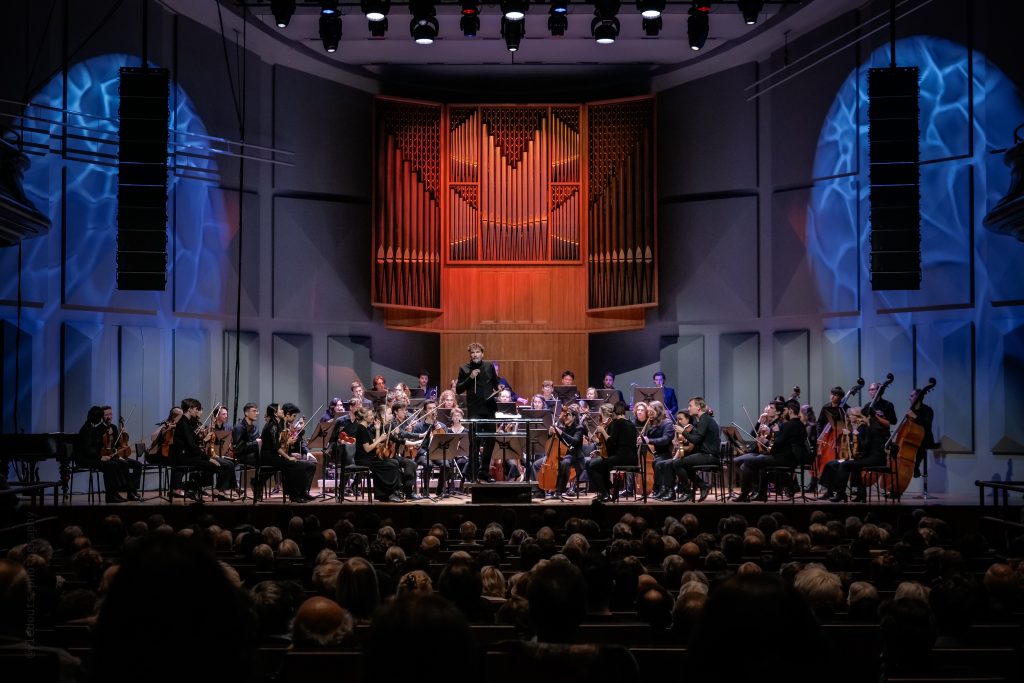English translation on the bottom

Planning
Program 1, January 26–31, 2026
Symphony nr. 2 in D, op. 36 and Symphony nr. 4 in Bes, op. 60
Orchestra: 7,6,5,5,3 (26 strings) 2-2-2-2 (woodwind) 2-2-0-0 (brass) timpani (minimum 39 musicians)Program 2, June 15-20, 2026
Symphony nr. 1 in C, op. 21 and Symphony nr. 3 in Es, Eroica, op. 55
Orchestra: 7,6,5,5,3 (26 strings) 2-2-2-2 (woodwind) 3-2-0-0 (brass) timpani (minimum 40 musicians)Program 3, September 28–October 3)
Symphony nr. 5 in c, op. 67 and Symphony nr. 6 in F, Pastorale, op. 68
Orchestra: 7,6,5,5,3 (26 strings) 3*-2-2-3* (woodwind) 2-2-3-0 brass) timpani (minimum 44 musicians)Program 4, March 1–6, 2027
Symphony nr. 7 in A, op. 92 and Symphony nr. 8 in F, op. 93
Orchestra: 7,6,5,5,3 (26 strings) 2-2-2-2 (woodwind) 2-2-0-0 (brass) timpani (minimum 39 musicians)Program 5, June 28 – July 4, 2027
Symphony nr. 9 in d, Choral, op. 125 (60
Orchestra: 7,6,5,5,3 (26 strings) 3*-2-2-3* (woodwind) 4-2-3-0 (brass) timpani+3 (minimum 49 musicians) choir (60?)
Planning
Program 1, January 26–31, 2026
Symphony nr. 2 in D, op. 36 and Symphony nr. 4 in Bes, op. 60
Orchestra: 7,6,5,5,3 (26 strings) 2-2-2-2 (woodwind) 2-2-0-0 (brass) timpani (minimum 39 musicians)Program 2, June 15-20, 2026
Symphony nr. 1 in C, op. 21 and Symphony nr. 3 in Es, Eroica, op. 55
Orchestra: 7,6,5,5,3 (26 strings) 2-2-2-2 (woodwind) 3-2-0-0 (brass) timpani (minimum 40 musicians)Program 3, September 28–October 3)
Symphony nr. 5 in c, op. 67 and Symphony nr. 6 in F, Pastorale, op. 68
Orchestra: 7,6,5,5,3 (26 strings) 3*-2-2-3* (woodwind) 2-2-3-0 brass) timpani (minimum 44 musicians)Program 4, March 1–6, 2027
Symphony nr. 7 in A, op. 92 and Symphony nr. 8 in F, op. 93
Orchestra: 7,6,5,5,3 (26 strings) 2-2-2-2 (woodwind) 2-2-0-0 (brass) timpani (minimum 39 musicians)Program 5, June 28 – July 4, 2027
Symphony nr. 9 in d, Choral, op. 125 (60
Orchestra: 7,6,5,5,3 (26 strings) 3*-2-2-3* (woodwind) 4-2-3-0 (brass) timpani+3 (minimum 49 musicians) choir (60?)
De complete Beethovens symfonieën zijn veelvuldig uitgevoerd door gespecialiseerde orkesten en ensembles en in de jaren tachtig en negentig opgenomen met oude instrumenten, en het repertoire is sindsdien herhaaldelijk herzien. Je zou daarom kunnen denken dat een nieuwe benadering weinig nieuws kan opleveren.
Dat zou een grote vergissing zijn.
In de afgelopen twee decennia is de kennis van de uitvoeringspraktijken uit de klassieke en romantische periode dramatisch verbeterd. We weten nu dat veel van de conventies die werden toegepast in vroege opnamen met oude instrumenten — strikte tempo’s, inflexibele ritmes, late-20e-eeuwse streektechnieken en articulaties — wezenlijk in strijd zijn met wat Beethoven en zijn tijdgenoten verwachtten.
Het is van vitaal belang om de manieren waarop we Beethovens muziek uitvoeren voortdurend te heroverwegen. Alleen zo kunnen we voorkomen dat we vervallen in herhaling en de muziek reduceren tot een louter mooi klankfenomeen. De meest inspirerende en dynamische kracht die ons helpt om nieuwe perspectieven op Beethovens muziek te ontwikkelen, blijft historisch onderzoek. Via het pad van de historisch geïnformeerde uitvoeringspraktijk (Historically Informed Performance Practice) kunnen musici ingesleten conventies overwinnen en de expressieve kracht van vergeten 19e-eeuwse speelstijlen en expressieve middelen herontdekken. Dit vereist wel een open en onderzoekende houding ten aanzien van de onderzoeksresultaten. Vasthouden aan de esthetiek van de late 20e eeuw betekent zowel een verraad van de letter als van de geest van Beethovens bedoelingen.
Het bewijs is nu overweldigend dat Beethoven een flexibele opvatting van tempo had – inclusief een breed scala aan tempomodificaties en rubatopraktijken – die in geen enkele bestaande opname terug te horen is. De effectieve toepassing hiervan zou ons begrip van zijn muziek kunnen transformeren.
In mijn promotieonderzoek naar modificaties van tempo en ritme in de orkestmuziek van Brahms aan de Universiteit Leiden, heb ik een manier ontwikkeld om onderzoeksbevindingen met een orkest te onderzoeken en in klank om te zetten. Mijn aanpak leidt tot fundamenteel anders klinkende resultaten dan zowel mainstream als HIPP orkesten en ensembles laten horen, en heeft toch een duidelijke verbinding met historische uitvoeringspraktijken. In mijn aanpak fungeert het orkest als een soort laboratorium waarin experimenten kunnen leiden tot een nieuw begrip van historische expressieve middelen. Repetities, uitvoeringen en opnames met het orkest worden zo een spannend onderdeel van het onderzoek zelf. In het laboratorium van het orkest delen studenten, jonge professionals en ervaren deskundigen hun kennis, ervaring en perspectieven. Dit is een belangrijk gebleken als het gaat om het vinden van paden buiten de gevestigde tradities. De studenten zijn in meerdere opzichten belangrijk in deze context; ze helpen bij het creëren van een open klimaat waarbinnen nieuwe ontdekkingen kunnen worden gedaan en ze spelen een vitale rol in de verspreiding van de bevindingen.
De afgelopen drie jaar had ik een leerstoel aan de Seoul National University Seoul, als professor Historically Informed Performance Practice, terwijl mijn werk in Nederland voor het Conservatorium van Amsterdam, de Nieuwe Philharmonie Utrecht en het Narratio Quartet doorliep. Nu is mijn werk in Zuid-Korea afgerond, is mijn relatie met het CvA in rustiger vaarwater gekomen, en zijn de opnames van de complete Beethoven strijkkwartetten met het Narratio Quartet (een wereldpremière op periode-instrumenten) succesvol afgerond en uitgebracht. Dit stelt me in staat om een ambitieus plan voor te stellen in de thuisstad van mijn orkest.
Onder de vlag van de Nieuwe Philharmonie Utrecht stel ik voor de Beethoven Academy Utrecht te lanceren, om alle negen Beethoven-symfonieën te bestuderen en uit te voeren in 2026 en in het Beethovenjaar 2027.
_______________________________________
Complete cycles of Beethoven’s symphonies were recorded with period instruments in the 1980s and 1990s, and the repertoire has since been repeatedly revisited. It might therefore be assumed that a new approach would offer little that is genuinely fresh. This assumption is profoundly mistaken.
Over the past two decades the knowledge base of Classical and Romantic performance practices has advanced dramatically. We now know that many of the conventions applied in early period-instrument recordings — strict tempo, inflexible rhythm, late-20th-century bowing techniques and articulations — are fundamentally at odds with what Beethoven and his contemporaries expected.
It is vitally important to constantly reconsider the ways we perform Beethoven’s music. This can prevent us from falling into repetition and reducing the music to a mere beautiful sound phenomenon. The most inspiring and dynamic force that helps us find fresh perspectives on Beethoven’s music remains historical research. Through the pathway of Historically Informed Performance Practice, musicians can overcome ingrained conventions and rediscover the expressive power of forgotten 19th-century playing styles and expressive tools.
The evidence is now overwhelming that Beethoven assumed a far more flexible approach, including a wide range of tempo modifications and rubato practices that are absent from all existing recordings. Their effective application would transform our understanding of his music. To persist with the late-20th-century aesthetic is to betray both the letter and the spirit of Beethoven’s intentions.
In my PhD research into unprescribed modifications of tempo and rhythm in orchestral music of Brahms, at Leiden University, I have developed a way to investigate research findings with an orchestra, resulting in profoundly different sounding results with a clear connection to historical performing practices. In my approach, the orchestra functions as a kind of laboratory in which experimentation can lead to a new understanding of historical expressive tools. Rehearsals, performances and recordings with the orchestra thus become an exciting part of the research itself. In laboratory of the orchestra, students, young professionals and seasoned experts, shared their knowledge, experience and perspectives. This has proven a particularly important quality when it comes to finding paths outside the established traditions. The students are a key factor in creating an open climate in which new discoveries can be made and they play a vital role in dissemination of the findings.
For the past three years, I have been working in Seoul as a professor of Historically Informed Performance Practice at the Seoul National University, while my commitments in the Netherlands for the Conservatory van Amsterdam, the Nieuwe Philharmonie Utrecht, and the Narratio Quartet continued. Now, I have completed my work in South Korea, my relationship with the CvA, to which I have been connected for over 35 years, has settled into calmer waters, and the recordings of the complete Beethoven string quartets with the Narratio Quartet (a world premiere on period instruments) has been completed and released. This allows me to present an ambitious plan in the home city of my orchestra.
Under the umbrella of de Nieuwe Philharmonie Utrecht, I propose to launch the Beethoven Academy Utrecht, offering participants the opportunity to study and perform all nine Beethoven symphonies in the lead-up to the Beethoven year.

